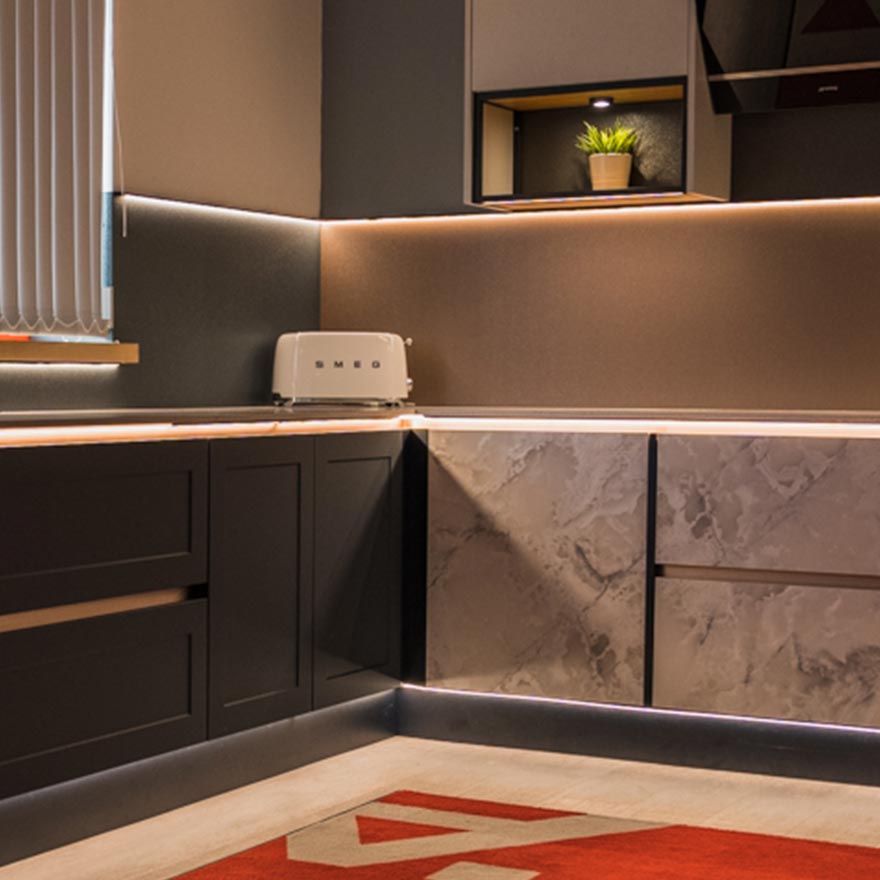Kitchen Lighting Trends 2024
As we make our way through 2024, kitchen lighting is evolving beyond mere functionality to become a key element in design and ambience. For kitchen designers and installers, staying ahead of these trends is essential to create spaces that are both beautiful and practical. Let's explore the hottest kitchen lighting trends shaping the year ahead.
Natural Kitchen Lighting Design Ideas
Sustainability and biophilic design are at the forefront of home design, and kitchen lighting is no exception. Natural materials like rattan, bamboo, and even stone are being incorporated into fixtures, adding warmth, texture, and a connection to nature. Think woven pendant shades that diffuse light softly, creating a warm and inviting atmosphere. Bamboo sconces can add a touch of rustic elegance, while chandeliers with stone accents can introduce a touch of luxury. These natural elements not only look beautiful but also promote a sense of well-being in the kitchen.

Layered Lighting
The days of relying solely on harsh overhead lighting are long gone. In 2024, kitchens are embracing layered lighting schemes that combine different types of fixtures to create a more nuanced and welcoming feel. Here's a breakdown of the key layers:
- General Ambient Lighting: This provides overall illumination throughout the kitchen. Recessed spotlights are a popular choice, but track lighting can also be effective, especially in larger kitchens or those with open floor plans. Consider using dimmers on the general ambient lighting to allow for adjustments based on the time of day and activity.
- Task Lighting: This is essential for food preparation areas. Pendant lights above the kitchen island are a classic choice, providing focused illumination for chopping, prepping, and cooking. Under-cabinet lighting is another great option, casting light directly onto countertops and eliminating shadows. Consider using LED light strips or puck lights for under-cabinet lighting, as they are energy-efficient and provide a clean, modern look.
- Accent Lighting: This layer is used to highlight specific features or create a mood. Wall sconces can be placed on either side of the sink or cooktop to provide additional task lighting, or they can be used to illuminate artwork or decorative objects. Recessed accent lights can also be used to highlight architectural details, such as a backsplash or a tray ceiling.
- Decorative Lighting: This layer is all about adding personality and visual interest to the kitchen. Chandeliers, pendant lights with unique shapes or finishes, or even decorative sconces can all be used as decorative lighting. When choosing decorative lighting, be sure to consider the overall style of the kitchen and ensure that the scale of the fixture is appropriate for the space.

Bold and Colourful
While neutrals will always have a place in kitchen design, 2024 is seeing an increase in homeowners embracing bolder colours and more playful accents in their kitchens. Lighting can be a great way to achieve this. For example, pendant lights are a popular canvas for colour expression. Imagine a jewel-toned emerald pendant light casting a warm glow over a breakfast nook, or a cobalt blue chandelier adding a pop of colour to a neutral kitchen island. Colourful glass shades are another way to introduce vibrancy. Frosted glass pendants in shades of amber or smoky rose can add a touch of sophistication, while clear glass pendants with brightly coloured bulbs can create a more playful look. Even fabric lampshades can be a fun way to incorporate colour. Opt for geometric patterns or bold floral prints to add a touch of personality to your lighting scheme.

Smart Home Integration
Smart home technology continues to advance by leaps and bounds, and kitchen lighting is getting smarter too. Voice-activated controls allow homeowners to turn lights on and off, adjust brightness, and even change the colour temperature with simple voice commands. This is not only convenient but also allows for hands-free operation, which can be especially helpful when cooking. Programmable schedules can be set to automatically adjust lighting throughout the day. For example, lights can be programmed to gradually brighten in the morning to mimic sunrise or to dim and turn warm in the evening to create a more relaxing atmosphere. Smart lighting systems can also be integrated with other smart home devices, such as security systems or thermostats, creating a truly connected kitchen.

Lighting Fixtures as Art
The humble light fixture is no longer utilitarian; it has evolved into an art form of its own. No longer relegated to the shadows, these luminous sculptures now take centre stage in kitchens and living spaces alike. Oversized chandeliers, reminiscent of waterfalls or delicate floral arrangements, command attention with their impressive scale and intricate design. Sculptural pendants, crafted from unexpected materials like handblown glass, woven rattan, textured paper, or even recycled metal, add a touch of intrigue. Artistic wall sconces, resembling miniature abstract paintings or geometric marvels, transform walls into galleries of light and shadow. These eye-catching pieces become conversation starters, infusing spaces with personality and a touch of drama.

Retro Revival
A wave of nostalgia is sweeping through kitchen design, and lighting is a big part of this. Retro-inspired fixtures, reminiscent of bygone eras, are experiencing a bit of a renaissance. Think schoolhouse pendants that hark back to turn-of-the-century classrooms, Sputnik chandeliers channelling the mid-century space age, and sleek sconces with art deco flair. These vintage-inspired pieces, often featuring warm Edison bulbs, gleaming brass finishes, and playful geometric shapes, infuse modern kitchens with personality, history, and a touch of playfulness. The soft glow of the bulbs delivers an inviting ambience, while the reflective surfaces of brass add warmth and sophistication. Whether it's the spherical allure of globe pendants or the elegant curves of bell jar fixtures, these shapes inject visual interest into the space.

Tips for Designers and Installers
- Embrace the Layers: Don't be afraid to mix and match different types of lighting to create a dynamic and functional scheme.
- Think Beyond the Ceiling: Explore creative placements for lighting, such as toe-kick lighting, inside cabinets, or even highlighting artwork.
- Incorporate Dimmers: Dimmers provide flexibility and allow homeowners to adjust the lighting to suit different moods and activities.
- Prioritize Energy Efficiency: LED technology and smart lighting options are great ways to reduce energy consumption and lower utility bills.
By incorporating these trends into your designs, you can create kitchen lighting schemes that are not only on-trend but also timeless and adaptable to individual client preferences. If you need an extra hand our free Lighting Design Service gives you access to our team of experts. They can act as an extension of your team helping you transform your design with creative, technical lighting schemes.










